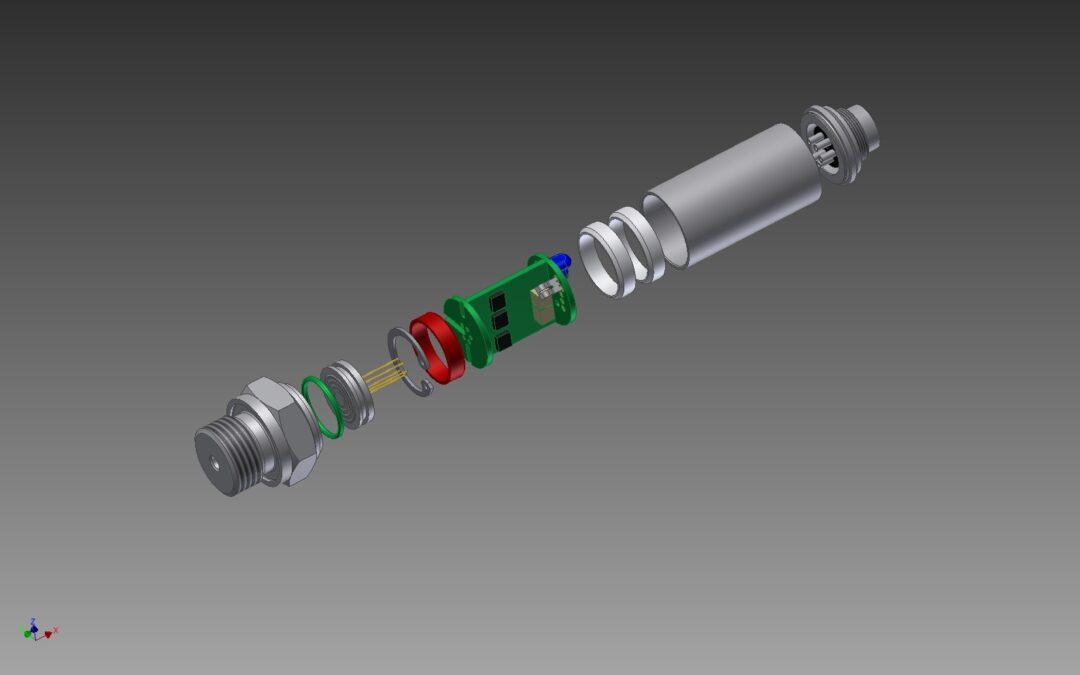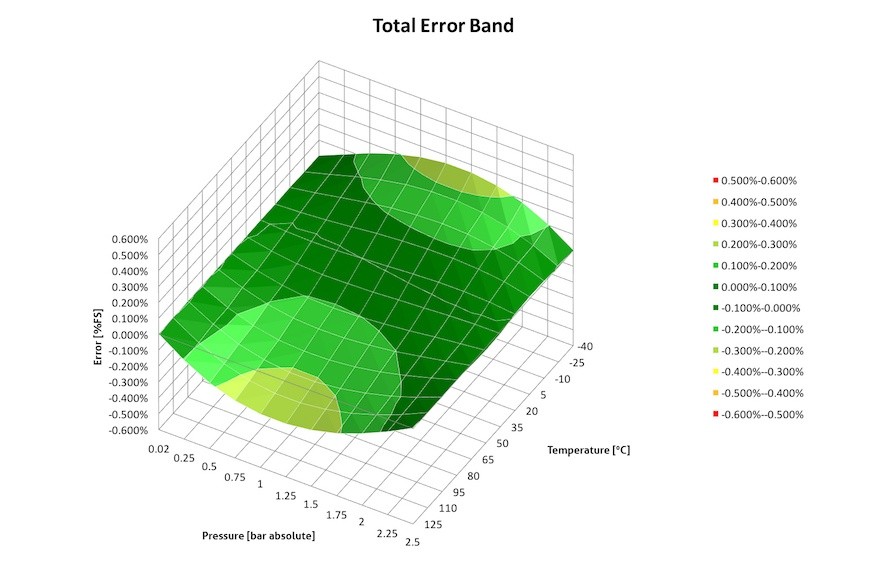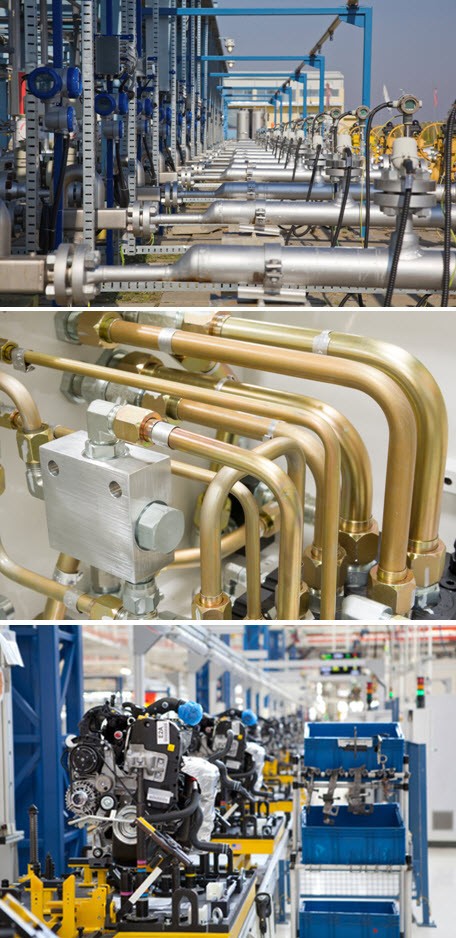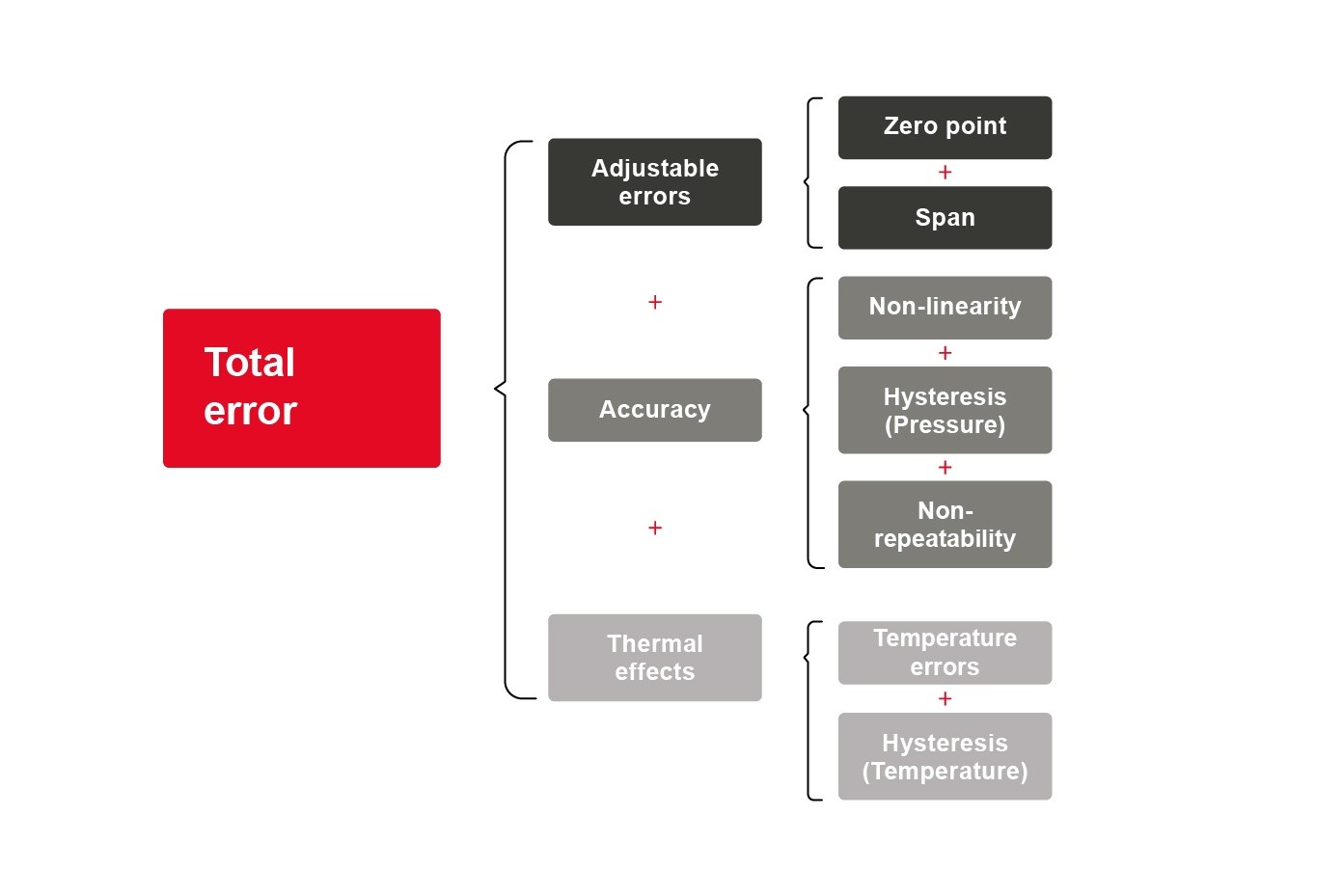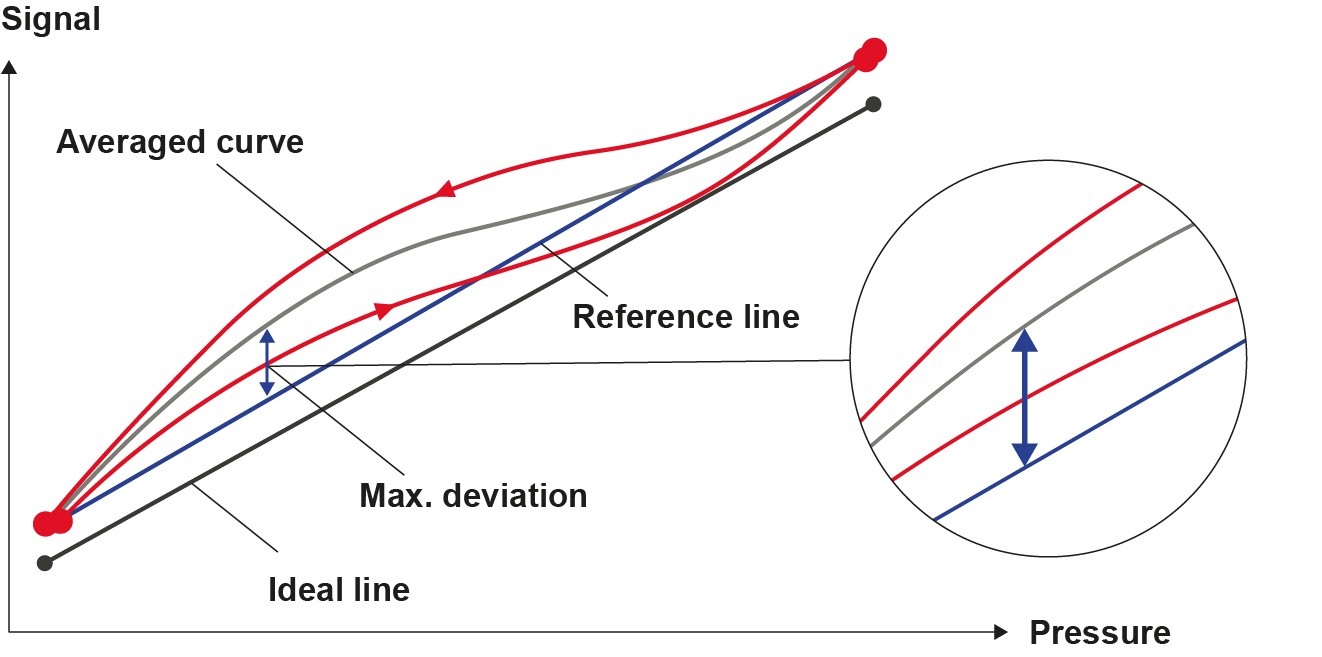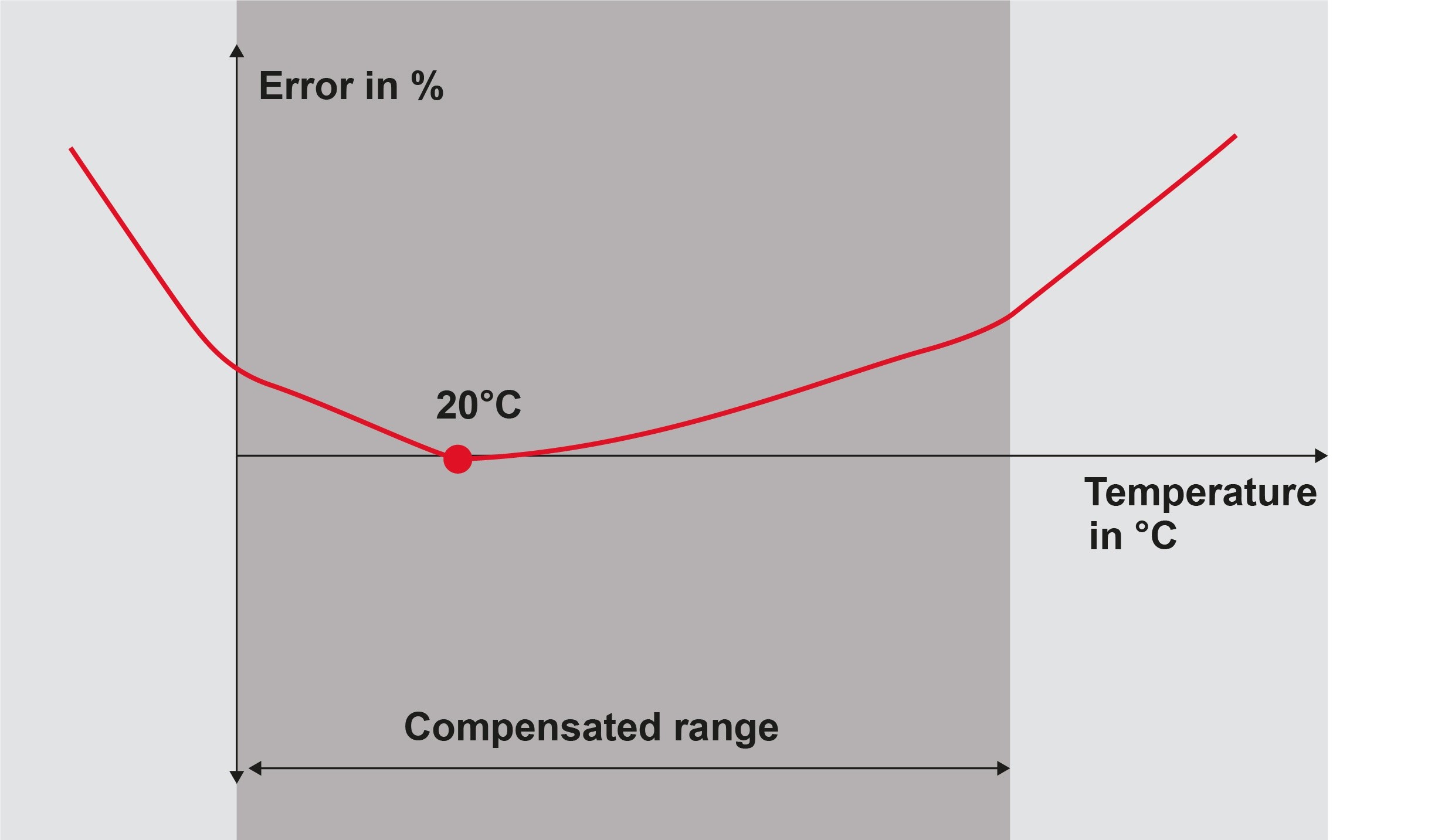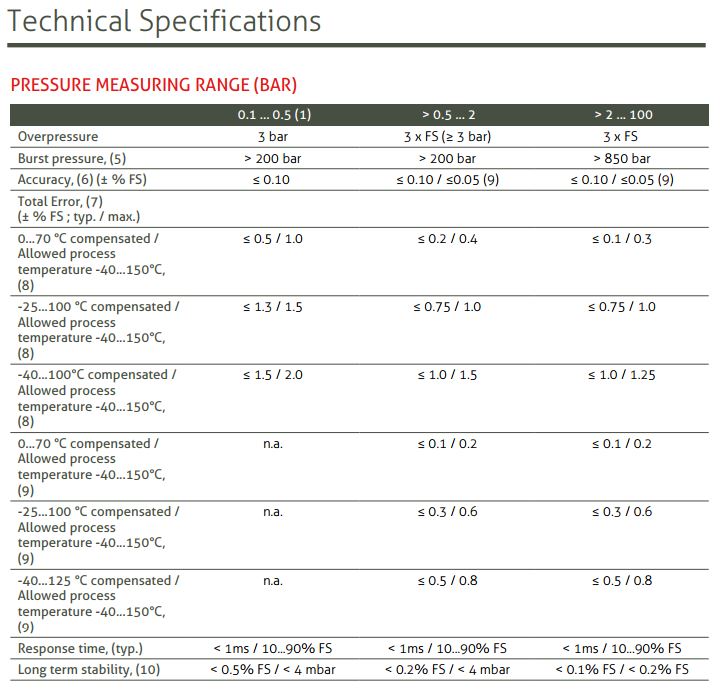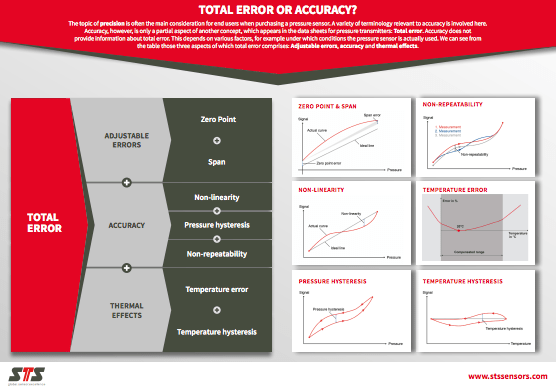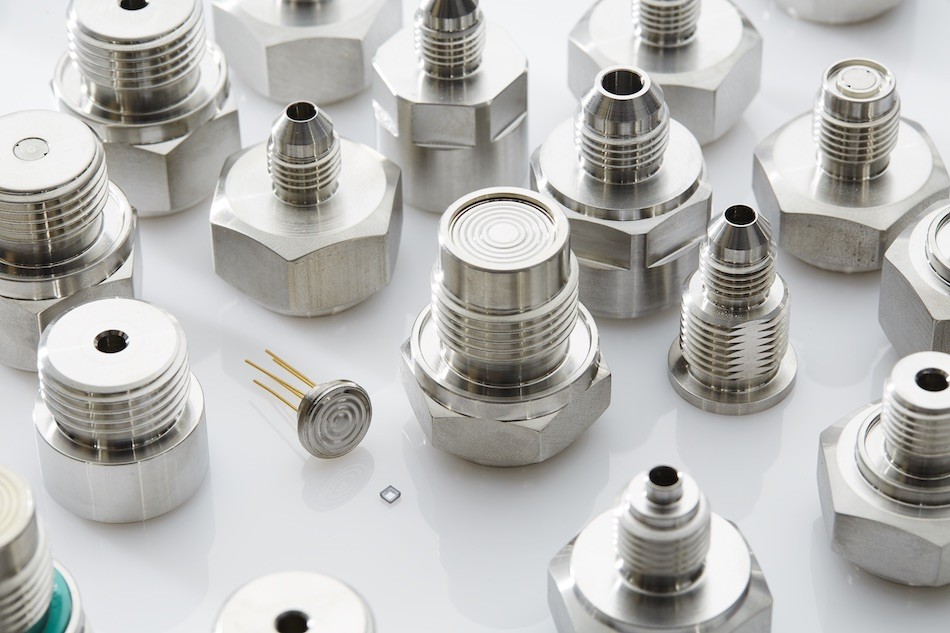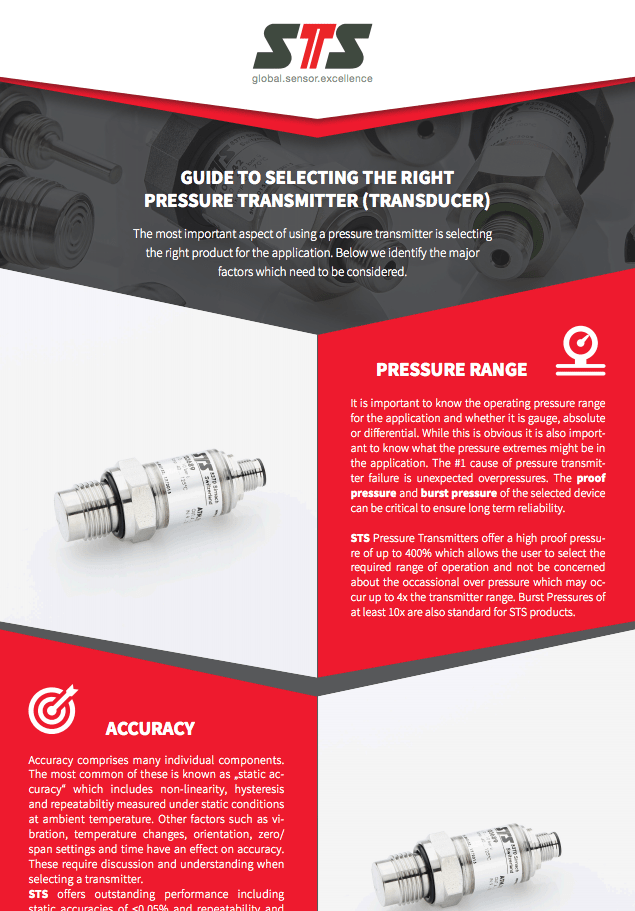There is a multitude of terms that are commonly used in association with pressure management. These are referenced on the STS datasheets, included in our articles and used throughout the industry in general. While some may be familiar, others might need explanation. In order to provide you with a clear overview, we created a glossary that features all relevant terms.
Most important of all surely is the definition of the term “sensor“. This term is used to describe a device which accepts fluid or gas pressures through the process connector and outputs an electrical signal proportional to the pressure. Other words for such a device are transducer or transmitter.
In the following, we provide you with an overview of the most essential, repeatedly used terms. You’ll find all of them sorted in alphabetical order:
A
Absolute Pressure (a)
Pressure measured relative to a perfect vacuum (zero pressure) reference.
Accuracy
There is no single interpretation of accuracy for a pressure sensor. Throughout this glossary there are many terms which relate to potential performance of the sensor generated by the operating conditions. The most common reference to accuracy is that described under Static Accuracy. However, this does not include other features such as Thermal effects, Zero and Span settings and Long Term Stability. The next best accuracy statement is described under Total Error Band.
Ambient Conditions
The condition around the sensor (humidity, temperature, pressure, etc.)
Ambient Pressure
The pressure of the medium surrounding the sensor.
Ambient Temperature
The average or mean temperature of the surrounding air which comes in contact with the equipment and instrument under test.
Amplifier
An electronic device which increases the output signal from the sensor to a higher level. For example, mV to Volts.
Analog Output
A voltage or current signal that is a continuous function of the measured parameter. For example, 0-5 Vdc, 4-20 mA.
ANSI
American National Standards Institute
ASTM
American Society for testing and materials.
B
Background noise
The total noise from all sources of interference in a measurement system independent of the presence of a data signal.
Best Fit Straight Line (BFSL)
The straight line fitted through a set of points which minimizes the sum of the square of the deviations of each of the points from the straight line (‘least-squares’ method). See also Pressure Non-Linearity.
Bit
A bit, or binary digit, which represents a single item of high/low, yes/no, or on/off information.
Breakdown Voltage
The AC or DC voltage, which can be applied across the insulation portion of a sensor without arcing or conduction above a specific current value.
Bridge Resistance
The Input Impedance of an uncompensated unamplified analog output product.
BTU
British Thermal Unit. The quantity of thermal energy required to rise one pound of water 1°F at or near its maximum density (39.1°F) (1055J).
Burst Pressure
The maximum pressure that may be applied to any port of the product without causing escape of pressure media. The product should not be expected to function after exposure to any pressure beyond the burst pressure. See also Proof Pressure (Overpressure).
Byte
A byte is a set of 8 bits, which is treated as an entity. Most computers handle data bits as bytes because it is a power of two. A byte with parity is a 9 bit used for error detection.
C
Calibration
(1) A test during which known values of pressure are applied to the sensor and corresponding output readings are recorded under specified conditions.
(2) The matching of a pressure controller or indicator to the characteristics of a specific sensor.
Calibration Cycle
The period of time between calibrations.
Centigrade
A temperature scale defined by 0°C at the ice point and 100°C at the boiling point of water at sea level.
Checksum
A checksum is an additional byte or bytes of data appended to a message group containing the arithmetic sum of all previous bytes. In HART communications, the checksum is truncated to the single least significant byte.
Common Mode Pressure
The applied ‘line’ or ‘static’ pressure which is common to both ports of a Differential Pressure Sensor.
Common Mode Pressure Maximum
The maximum pressure that can be applied simultaneously to both ports of a Differential Pressure Sensor without causing changes in specified performance.
Common Mode Voltage
The voltage between each of the output terminals of a differential output product and electrical ground.
Compensation
The signal conditioning used to create a calibrated product to achieve the published specification.
Compensated Temperature Range
The temperature range (or ranges) over which the product will produce an output proportional to pressure within the published specifications.
Compound Range Pressure Sensor
Product for measuring Gage pressures both above and below atmospheric pressure. Typically the Minimum Operating Pressure (Pmin.) is set to -1 bar (-14.5 psi) below atmospheric pressure.
Configuration
The process of setting parameters, values and data which will determine how a sensor will perform.
Current Loop
A two-wire loop in which the current through the wires is maintained according to a controlling device, usually a two-wire sensor. The advantages of a current loop are longer distance signal transmission, better noise immunity, and the ability to power the two-wire sensor throughout the same two wires. The most common current loop is 4 to 20 mA.
D
Damping
See Filter (Electronic) or Snubber (Pneumatic)
DC
Direct Current
Dead Volume
The open volume inside the sensor which is occupied by fluids or gasses being sensed. Does not include the flow channel for flow applications.
Differential Pressure (d)
Pressure difference measured between two pressure sources.
Differential Pressure Sensor
Product whose output is proportional to the difference between pressure applied to each of the pressure ports. Often used to measure flow either side of an orifice plate.
Digital Output
The output signal from a sensor in digital format. For example, RS485, CAN, HART, etc.
Drift
An undesired change that takes place in a pressure sensor over time. It generally only effects the zero and span. This is not to be confused with the thermal effects of the sensor which is often incorrectly referred to as drift.
E
End Point
The pressure output of the sensor at the range extremes. Normally zero and Full Scale but in some cases zero can be offset – see compound range.
Environmental Conditions
All conditions to which a sensor may be exposed during shipping, storage, handling, and operation.
Error (Error Band)
See Total Error Band
Excitation
The supply voltage to the sensor.
F
Fahrenheit
A temperature scale defined by 32°F at the ice point and 212°F at the boiling point of water at sea level.
Filter (Electrical)
A device to sort desired result from undesired. Electrically, a selective circuit which passes through certain frequencies, while attenuating or reject others.
Filter (Pneumatic)
See Snubber
FM Approved
A sensor that meets a specific set of requirements established by the Factory Mutual Research Corporation which sets industrial safety standards.
Full Bridge
See Wheatstone Bridge
Full Scale
The output from a sensor at the specified full scale pressure range. This is not to be confused with span. See span.
G
Gage Pressure (g)
Pressure measured relative to the local ambient (atmospheric/barometric) pressure. Also known as ‘Gauge’.
Gage Pressure Sensor
Product whose output is proportional to difference between applied pressure and local ambient (atmospheric) pressure. Typically the Minimum Operating Pressure (Pmin.) is set to atmospheric pressure.
Gain
The ratio of the change in output to the change in input, which creates it.
Ground
The reference point of an electrical system, or alternatively, the local earth potential (earth ground).
H
Half Bridge
See Wheatstone Bridge
HART Protocol
Highway Addressable Remote Transducer (a digital protocol).
Heat
Thermal energy, expressed in units of calories or Btu`s.
Hysteresis
Deviation in output within the sensor range from ascending to descending for both pressure and temperature.
I
Input Impedance
The electrical impedance measured across the input terminals of the product (as presented to the excitation source, with the output terminals open-circuited).
Insulation Resistance
The resistance measured between specified insulated portions of a sensor when a specific DC voltage is applied at room conditions.
Intrinsically Safe
An sensor which has been installed such that it will not produce any spark or thermal effect, under normal or abnormal conditions, that will ignite a specified gas mixture.
ISO
International Organization for Standardization. A worldwide federation of national standards bodies from some 140 countries.
J
Jumpers
Wire links that allow for changes to be made in input and output sensor configurations.
K
Kelvin
The units of absolute or thermodynamic temperature scale based upon the Celsius (centigrade) scale with 100 units between the ice point and boiling point of water. 0°C = 273.16K (there is no degree [°] symbol used with the Kelvin scale).
L
Linearity
The maximum deviation of the sensor output from a defined straight line during increasing pressure in a calibration cycle. See Accuracy.
Long Term Stability
This is generally quoted as the annual stability and is a combination of the sensitivity and Zero drift over 12 months.
Long Term
Stability is extremely subjective and is dependent upon the changes of environmental conditions, but based on a benign at room temperature.
M
Measurand
A physical quantity, property or condition which is measured. The term measurand is preferred to “input”, “parameter to be measured”, “physical phenomenon”, “stimulus”, and/or “variable.
Mounting Error
The error resultant from installing the pressure sensor, both electrical and mechanical.
N
NEMA
The National Electrical Manufacturers Association, which defines enclosures for indoor or outdoor use primarily to provide a degree of protection against dust, rain, and/or splashing water.
NIST
National Institute of Standards and Technology. The US reference for all pressure measurement standards.
Noise
An unwanted signal which can contribute to errors in measurement. Examples are hum (power lines), radio frequency interference (RFI), electromagnetic interference (EMI), and broadband or white noise.
Normally Closed (NC)
The state of a switching device (relay or SSR) whose non-powered state is connected.
Normally Open (NO)
The state of a switching device (relay or SSR) whose non-powered state provides no connection.
O
Offset
The output signal obtained when the Reference Pressure is applied to the pressure port. Also known as “null” or “zero”.
Offset Error
The maximum deviation in measured Offset at Reference Temperature relative to the ideal (or target) Offset as determined from the specification. Often defined as % FS.
Operating Pressure Minimum (Pmin.)
The lower limit of the Operating Pressure Range.
Operating Temperature Range
The temperature range over which the product will produce an output proportional to pressure but may not remain within the specified performance limits. See also Compensated Temperature Range.
Orientation Sensitivity
The maximum change in Offset of the sensor due to a change in position or orientation relative to the Earth’s gravitational field (g).
Output
The electrical signal, which is produced by a pressure applied to the sensor.
Output Impedance
The electrical impedance measured across the output terminals of the product (as presented to an external circuit).
Output Resolution
The smallest difference between output signal readings which can be meaningfully distinguished or resolved.
Overpressure
The Absolute Maximum Rating for pressure which may safely be applied to the product for it to remain in specification once pressure is returned to the Operating Pressure Range. Exposure to higher pressures may cause permanent damage to the sensor. Unless otherwise specified, this applies to all available pressure ports at any temperature within the Operating Temperature Range. Also known as ‘Proof Pressure’. See also Working Pressure.
P
Polarity
Most sensors operate from a Direct Current (DC) supply where the positive and negative connections are specified. Such sensors are generally protected from “reverse” polarity connection.
Position Sensitivity
See Orientation Sensitivity.
Potentiometer
A variable resistor often used to set zero and Full Scale within an analog output sensor.
Power Consumption Maximum
The maximum electrical power consumed in normal operation of the product, dependent upon the Supply Voltage and any internal power saving modes of the product.
Power Supply
A separate unit or part of a circuit that supplies power to the rest of the circuit or to a system including the sensor.
Pressure Hysteresis
The maximum difference between output readings when the same pressure is applied consecutively, under the same operating conditions, with pressure approaching from opposite directions within the specified Operating Pressure Range.
Pressure Non-Linearity
The maximum deviation of sensor output from a straight line fitted to the output measured over the specified Operating Pressure Range. Standard methods of straight line fit specified for this calculation are either B(F)SL, BFSL through Zero (Best FIT Trough Zero) or TSL (End Point). See Total Error Band.
Pressure Range
The pressure values over which a sensor is intended to measure, specified by their upper and lower limits.
Pressure Repeatability
The maximum difference between output readings when the same pressure is applied, under the same environmental conditions, with pressure approaching from the same direction. This is considered short term i.e. measurement taken within a few minutes of the original but still under the same environmental conditions.
Pressure Response Time
Time taken for output of the product to change from 10% to 90% of Full Scale Span in response to a step change in input pressure from the specified Minimum to Maximum Operating Pressure.
Proof Pressure
The maximum amount of pressure that can be applied to a pressure sensor without changing any specification. See maximum pressure. See Overpressure.
PSIA
PSI is the most common measurement of pressure used in North America. It is the measurement of pounds per square inch. (A) absolute pressure is referenced to a vacuum.
PSIG
PSI is the most common measurement of pressure used in North America. It is the measurement of pounds per square inch. (G) Gage pressure is referenced to ambient air pressure.
R
Range
The upper and lower pressure limits that a sensor is required to measure.
Ratiometricity
See Supply Voltage Ratiometricity.
Reference Pressure
The pressure used as a reference (zero) in measuring product performance. Unless otherwise specified, this is vacuum (0 psi a) for an Absolute Pressure Sensor and local ambient atmospheric pressure (0 psi g) for Gage, Compound and Differential Pressure Sensors.
Reference Supply Voltage
The voltage excitation used as a reference in measuring sensor performance. For example 5.00 ±0.01 Vdc.
Reference Temperature
The temperature used as a reference in measuring sensor performance. For example 25 ±3 °C or 75 ±5°F.
Repeatability
See Pressure Repeatability.
Reranging
A procedure allowing the user to reconfigure the sensor to a different range than originally established.
Resolution
See Output Resolution.
RFI
Radio Frequency Interference.
Room Conditions
The ambient conditions used for both the calibration and operation.
S
Sealed Gage
This is a pressure measurement reference to one standard atmosphere which is sealed within the sensor.
Self Heating
Internal heating of a sensor as a result of power dissipation.
Sensing Element
The part of a sensor, which reacts directly in response to the pressure.
Sensitivity
The ratio of output signal change to the corresponding input pressure change. Sensitivity is determined by computing the ratio of Full Scale Span to the specified Operating Pressure Range. Also known as “Slope”.
Sensor
That component of a transducer or transmitter which converts the fluid or gas pressure into an electrical signal.
Shield
A protective enclosure surrounding a circuit or cable which is to protect it from an electrical disturbance such as noise.
Shift
An ambiguous term sometimes used to describe a permanent change in output of a sensor. The terms ‘Offset Shift’ and ‘Span Shift’ are also sometimes used to describe output changes due to temperature. To avoid confusion, these should be replaced by Thermal Effect on Zero (Offset) and Thermal Effect on Span. See also Drift.
Shunt Calibration/Rcal
A method of generating an electrical output to match the electrical output that would be given in response to an applied pressure. This is accomplished using a resistor to unbalance the bridge electrically rather than with strain introduced by applied pressure. With standardized shunt or Rcal, the same point (generally 80%) is chosen on the calibration curve so that all similar sensors calibrate at the same point to facilitate interchangeability.
Sink Current
The maximum current an amplified circuit can accept (‘sink’) on its output pin and still remain within the specified performance limits.
Snubber
This is a mechanical addition to the process connector which can eliminate damage by high frequency pressure spikes such as water hammer.
Source Current
The maximum current an amplified circuit can supply (‘source’) on its output pin and still remain within the specified performance limits.
Span Error
The maximum deviation in measured Full Scale Span at Reference Temperature relative to the ideal (or target) Full Scale Span as determined from the calibration standard. See also Thermal Effect on Span.
Stability
The ability of a sensor to retain its performance characteristics with time. This is generally considered to be Long Term Stability and will be random.
Static Accuracy
This is considered to be the accuracy of the sensor referenced to B(F)SL, BSL forced Zero (Best Fit Through Zero) or TSL (End Point) including linearity, hysteresis and repeatability under room conditions.
Static Calibration
See Total Error Band.
Static (Line) Pressure
Applicable to differential pressure measurement where a small differential pressure is to be measured at a high static line pressure.
Storage Temperature Range
The temperature range over which the sensor may safely be exposed without excitation or pressure applied. Under these conditions the sensor will remain in specification after excursion to any temperatures within this range. Exposure to temperatures outside this range may cause permanent damage to the sensor.
Strain
A technical term synonymous with deformation.
Strain Gage
A measuring element for converting force, pressure, tension, etc., into an electrical signal. Commonly recognized as part of a Wheatstone Bridge which is used in many pressure measuring elements.
Supply Current
Corresponds to the current drain on the supply terminal, dependent upon the Supply Voltage.
Supply Voltage Operating Limits
The range of voltage excitation which can be supplied to the product to produce an output which is proportional to pressure but due to Supply Voltage Ratiometricity errors may not remain within the specified performance limits.
Supply Voltage Ratiometricity
The maximum deviation in ratiometric output of the product (Output divided by Supply Voltage) resulting from a voltage excitation which is different from the Reference Supply Voltage but remaining within the Supply Voltage Ratiometric Limits.
Supply Voltage Ratiometric Limits
The range of voltage excitation required by the product to remain within the specified performance limits for Supply Voltage Ratiometricity.
T
Terminal Straight Line (TSL)
The straight line fitted through the end points of a set of data points.
Thermal Coefficient of Offset (TCO)
The Thermal Effect on Zero (Offset) expressed as an amount of Zero change occurring over a specified temperature change (e.g. TCO in % FS/25°C gives the amount of Offset change which occurs for a 25°C change in temperature). It should be noted that the %/° is an average value over the specified temperature range.
Thermal Coefficient of Resistance (TCR)
The deviation in Input Impedance due to changes in temperature over the specified temperature range, typically expressed as a ratio of the Input Impedance at Reference Temperature.
Thermal Coefficient of Span (TCS)
The Thermal Effect on Span expressed as an amount of Span change occurring over a specified temperature change (e.g. TCS in % FS/25°C gives the amount of Span change which occurs for a 25°C change in temperature). It should be noted that the %/° is an average value over the specified temperature range.
Thermal Effect on Zero (Offset)
The maximum deviation in Zero due to changes in temperature over the Compensated Temperature Range, relative to Zero, measured at Reference Temperature.
Thermal Effect on Span
The maximum deviation in Full Scale Span due to changes in temperature over the Compensated Temperature Range, relative to Full Scale Span, measured at Reference Temperature.
Thermal Error Band (TEB)
Not to be confused with Total Error Band referenced below. This is a combination of the Thermal coefficient of Zero (Offset) and span but expressed as a Band.
Thermal Hysteresis
The maximum difference between output readings when the same temperature is reached consecutively, under the same operating conditions, with temperature approaching from opposite directions within the specified temperature range.
Total Error Band (TEB)
The maximum deviation in output from the calibration standard over the entire Compensated Temperature and Pressure Range. Includes all errors due to: Zero Offset, Full Scale Span Setting, Pressure Non-Linearity, Pressure Hysteresis, Non-Repeatability, Thermal Effect on Zero Offset, Thermal Effect on Span and Thermal Hysteresis.
Transducer
In this context, transducer is generally applied to a device that takes a physical phenomenon such as pressure, temperature, humidity, flow, etc. and converts it to an electrical output. In general for pressure transducers they have a millivolt or voltage output.
Transmitter
A device which translates the low-level output of a sensor or transducer to a higher level signal which is suitable for transmission to a site where it can be processed further. In general a transmitter is similar to a transducer but provides a 4-20 mA current loop suitable for operation over longer distances.
U
Upper Range Limit (URL)
The highest value of the measured variable that the analog output of the sensor is capable of measuring. Upper Range Limit, URL, is factory set and not modifiable by the user.
Upper Range Value (URV)
The highest value of the measurand that the analog output of the sensor is currently configured to measure. Upper Range Value, URV, is a user settable entity.
W
Wetted Materials
Materials used in the product which may come into direct contact with measured fluids (media) applied to the pressure port(s).
Wheatstone Bridge
A simple circuit of four resistors (strain gages) attached or incorporated into the sensing element to form a full bridge with all elements active. Just two active resistors can be used with the bridge being completed on the circuit board. This is known as a half bridge.
Working Pressure
The maximum pressure that may be applied to the product in continuous use. This pressure may be outside the Operating Pressure Range in which case the product may not provide a valid output until pressure is returned to within the Operating Pressure Range.
Z
Zero Adjustment
Means of adjusting the zero pressure output of an amplified transducer.
Zero Balance (Offset)
The measured transducer output under room conditions with no pressure applied to the pressure port. For absolute pressure transducers, this value is measured at 0 psia. Gage and sealed pressure transducers have this value measured at atmospheric pressure.
